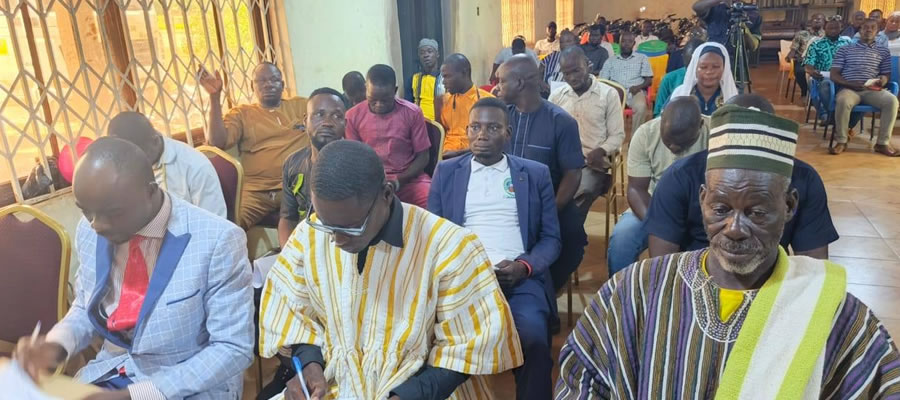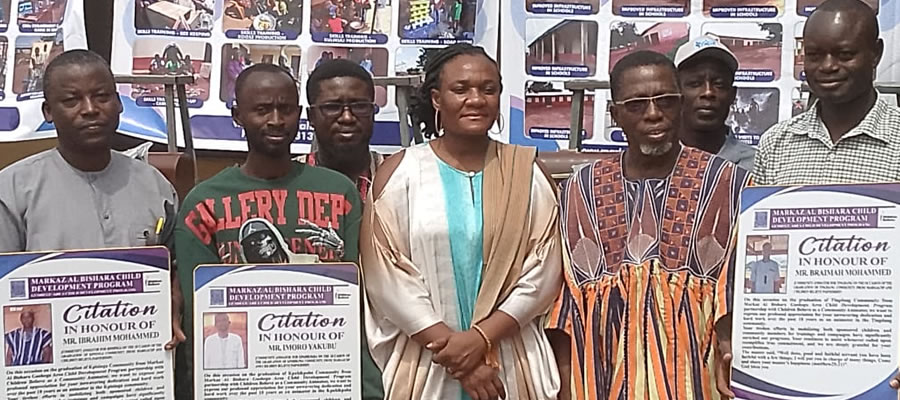

District Institutional Capacity
The focus of organizational development is to enhance efficiency of the institutional delivery process. The Local government Act 462 of 1993 entrusts development at the local level to the District Assemblies. This entails developing institutional policies, procedures, guidelines, plans and programs to chart a course for effective development. Over years of the District Assembly operational existence, there has been a lot of discourse on the capacity development level of the Assemblies. The need for institutional capacity assessment of the assembly and other development actors is quite essential for poverty reduction. The following key areas of organizational development are the targets of capacity assessment.
- District Assembly as Political Authority
- Departments of the Assembly as technical arm for development efforts
- Town and Area Councils and Unit committees as agents of grassroots development mobilization
- Non-Governmental Organizations as partners in local development efforts
- Collaborative efforts of all at the district level
- Participation of Women in Development Process
The District Assembly as Political Authority
The District Assembly is the highest political authority in the Municipality with legislative, executive and administrative powers. As a political body, the Assembly is composed of 60 members out of whom 42 are elected to represent electoral areas of the Municipality. The government appoints the remaining 18 members.
The District Assembly as a legislative body is presided over by a Presiding Member who is elected from among the members to serve for a period of two years. The District Chief Executive (DCE) who is nominated by the government and confirmed by not less than two-thirds members of the assembly and heads the Assembly. The District Assembly has the power of legislation, that is, to make bye-laws for local development. It also has responsibility for formulating and executing overall policies, programs and plans for local development.
Executive Committee
The Executive Committee of the assembly is the operational arms of the Assembly. Indeed the assembly’s functions are operationalized through the Executive Committee. Under the Local Government Act 462 (1993), the Executive Committee is responsible for the performance of the executive functions of the assembly. Specifically, the Executive Committee is to perform the following functions:
- Coordinate plans and programmes of the Sub-Committee and submit these as comprehensive plans of the District Assembly
- Implement resolutions of the Assembly
- Oversee the administration of the district in collaboration with the DCE
- Develop and execute approved plans of the Units, Areas and Towns in the district.
Sub Committees
In the performance of the above executive functions, the Gushegu Municipal Assembly has established the five statutory sub-committees as follows:
1. Development Planning
2. Finance & Administration
3. Justice & Security
4. Social Services
5. Works
The Municipality has in addition to the above statutory committees, established other committees to address the peculiar needs of the district. These are as follows:
1. Education
2. Women and Children
3. Environment
4. Public Relations and Complaints
5. Youth and Employment
Assessment of the General assembly
The current District Assembly’s four-year term of office has ended. It is indeed the third Assembly since the decentralisation system was established. A new Assembly will very soon take over from the old one. Assessment of their performance of the assembly is quite necessary especially in relation to their functions that they were deemed to be performing.
Generally, the membership of the previous assemblies has been composed of low caliber people as a result of their illiteracy levels. Apart from the initial orientation organised for the assemblies, no tailor made training programmes have been developed to enhance the deliberative capacities and performance of assemblypersons. The Sub-Committees with the specialized functions have not also been oriented on how to conduct their business. The role of the assembly members had been reduced merely to attending assembly sessions and ratifying what the assembly’s technocrats advised.
Office of the District Coordinating Council
The Office of the District Coordinating Council of the Gushegu Municipal Assembly consists of the office of the Municipal Assembly and decentralized departments. These constitute the technical arm of the Municipal Assembly. This office of the Municipal Assembly is composed of two units, that is, the Administrative and Planning Units.
The Administration
The administration consists of a Coordinating Director and a Deputy Coordinating Director with and other support staff. The Coordinating Director is of deputy director rank with first degree and a postgraduate diploma degree with over seventeen years of experience. The Deputy Coordinating Director also holds a first-degree. He has had a number of on -the-job-training
The District Planning Coordinating Unit
The unit is responsible for the overall planning, implementation and monitoring of district development programs. The unit has one officer with a planning related degree. He has worked in the Municipality for the past four years. He has undertaken a number of planning related training sponsored both by the Ministry of Local Government and other stakeholders to enhance his planning skills. He has an office, equipped with a computer and accessories. The office is also allocated a vehicle to enhance its program implementation and monitoring.
Decentralized Department
The local Government Act 462 of 1993 stipulates the existence of 11 decentralized department in the District Assembly. This means that the previous 22 decentralized departments have been merged into eleven. Indeed these decentralized departments are to be an integral part of the District Assembly structure.
In the Gushegu Municipality, not all the departments of the assembly exist. With the exception of the Central Administration, Finance, Health and Community Development, all other departments that exist do not have the full complement of their constituents units. The Works Department is not for instance physically present in the Municipality. The PWD and Feeder Roads have officers at the regional level who have oversight responsibility for the Municipality. Similarly, the Town and Country Planning Department for want of staff has assigned an officer at the regional level to take care of the Municipality.
Aside the fact that departments do not have the full constituent units, the situation is made worse by the lack of high caliber staff. This is particularly evident in the Social Welfare and Community Development/Trade and Industry and the Disaster Prevention Department.
One major constraint within the District Assembly system is the dual allegiance syndrome of the departments. With the exception of the central administration, which any way is the heart of the assembly; all staff of the other departments see themselves more as staff of their mother line ministry than of the assembly.
This dual allegiance issue has had a long pedigree and owes its origin to the previous Local Government Council System in which departments were only deconcentrated at the Council level. The other reason is that the departments still receive their Financial Encumbrances (FE) for their operations from their line ministry. Although it has long been recognized that the solution to the dual loyalty is in the composite budget system, not so much has been done to get the composite budget working.
Sub District Structures
Legislative Instrument 1589 of I994 established the Town /Area Councils. The sub-district structures of the assembly system were officially operational only in 1998. These sub-district structures are supposed to be rallying points of local enthusiasm in support of the development objective of the District Assembly. Unit Committees are the base structures of the decentralisation system with the responsibility of mobilising community members for local development.
There are two (2) Town and eleven (11) Area Councils in the Municipality. In each of these Councils, are a number of Unit Committees. The sub-district structures have not been functional since their inauguration in 1998. Structural as well as operational issues have hampered their functionality. One serious issue that is yet to be resolved operationally is the role of these Councils in the revenue generation system and the proportion of revenue generated that should be retained at the council level. Out of the 13 councils, only 9 have had their offices constructed. There were efforts in 1999 to recruit staff to get the system operational but this has not come to fruition. Support from central government has not materialised to get the system functional. The present plan would seek to strengthen the sub district structures in the next two years.
Other institutions
There are other para-statal and non-decentralized departments in the Municipality that contribute to the development of the Municipality.
These are:
- Commission on Human Rights and Administrative Justice (CHRAJ) National Commission on Civic Education (NCCE)
- Non formal Education Division (NFED).
The NCCE is responsible for not only inculcating in the people a sense of civic responsibility, but also a sense of human rights. The CHRAJ is to ensure that human rights abuses are prevented, resolved or punished. To reduce the literacy levels of especially the adults in the Municipality, the NFED has been established and operating in the Municipality for the past ten years. Impact studies of the NFED have not been done to assess the extent of successes of the project. The NFED is currently undergoing institutional review at the national level to redirect its strategy
Participation of Women in Development Process
Gender issues are crucial for development. Gender refers to the culturally constructed roles, responsibilities and expectations of both men and women. By virtue of the role of the woman in the Municipality, she is so overburdened that her contribution to the household and societal development is not recognised. The concern now is how can we get the men folk to assist women in their traditional roles? How can the burden of women be lessened so that they can participate meaningfully in the development process?
Indeed, the participation of women in the development process has now become a genuine issue. Studies have showed that the impact of women’s involvement in the process of development is not only beneficial to women alone, but to the household and the society at large.
Because gender is well adopted when it is mainstreamed into sectors, the Assembly has been working under different projects to mainstream and include women in the planning and implementation of projects. One sector that has achieved this well is the water and sanitation sub-sector. The Assembly will continue to ensure that women actively take part in the decision-making processes, especially at the Town and Area Council levels and at the community levels
Key Development issues affecting good governance in the Municipality
- Lack of skills of staff
- Lack of an effective Monitoring & Evaluation System
- Poor Local Government. Infrastructure
- High illiteracy rate among Assembly persons
- Poor capacity of Assembly persons
- Non-functional Town Area councils.
- Poor collaboration among development actors
- Low participation of women in Local Government
Date Created : 11/18/2017 4:56:22 AM









 facebook
facebook
 twitter
twitter
 Youtube
Youtube
 +233 593 831 280
+233 593 831 280 0800 430 430
0800 430 430 GPS: GE-231-4383
GPS: GE-231-4383 info@ghanadistricts.com
info@ghanadistricts.com Box GP1044, Accra, Ghana
Box GP1044, Accra, Ghana